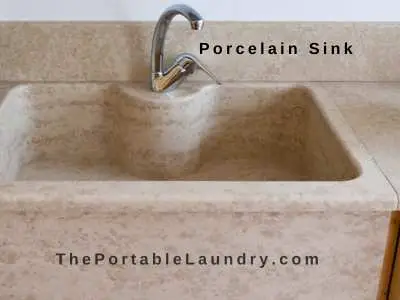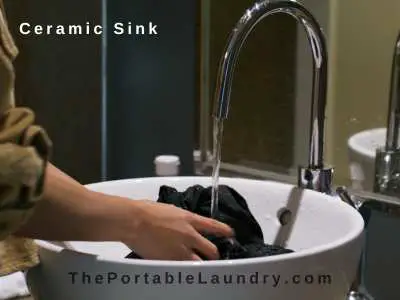There is no difference between a Laundry Sink and Utility sink, they both mean the same. The laundry Sink is often referred to as a utility sink and vice-versa. They are sturdy, large-capacity sinks typically used for washing or soaking clothes.
These Utility sinks are found in most homes and are mainly used for washing and rinsing clothes.
Even though the everyday use of a laundry sink is to wash clothes, it can also be used to wash car mats, floors, and other hard surfaces.
In this article, we will walk through what a laundry sink is and its types.
What Is a Laundry Sink?
A laundry sink is a place where dirty clothes are brought to be washed and sorted.
It’s basically a large rugged container where dirty clothes are washed and rinsed before drying.
They are a convenient place to hand wash your clothes and are usually found in kitchens and laundry rooms.
You do get a lot of flexibility in terms of placing them, they can either be wall-mounted or floor-mounted depending on the type of sink you want.
Additionally, they come in a variety of sizes and shapes.
What are Laundry Sinks OR Utility Sinks Made Of?
Laundry Sinks OR Utility Sinks Made Of are made of different materials and you can choose the one that best suits your needs.
Here are some of the most common materials used to make Laundry Sinks.
Stainless Steel Sinks
Stainless Steel Sinks are the most common types of sinks that are used in homes and commercial settings. They are easy to clean and maintain.
Furthermore, they are highly durable, reliable and able to withstand heat, and able to resist chemicals.
But be aware that stainless steel laundry sinks, can make noise when they are hit by water.
Furthermore, they are prone to denting and are a little bit on the expensive side.
Porcelain Sinks

Since porcelain sinks are either constructed of actual porcelain or a porcelain enamel covering, they are substantially heavier.
Since Porcelain sinks are highly durable, the majority of cleaning agents work well on porcelain sinks.
No stains or scratches are likely to occur on the porcelain enamel.
Furthermore, Porcelain Sinks deals with heat well.
Ceramic Sinks

Clays, fillers, and fluxes are combined and fused together during the firing process to create ceramic sinks.
Since Ceramic sinks are fired at high temperatures it produces a non-porous surface that is more stain-resistant and durable.
Some of the well-known benefits of ceramic sinks are that they are easy to clean and maintain, they resist heat and cold, repel bacteria, and are robust.
Acrylic Sinks
Sinks made up of acrylic are supported by fiberglass and resin.
It is manufactured using the heat-molding procedure to give the proper shape.
The majority of acrylic sinks are either white or off-white, which makes them prone to stains.
Furthermore, it may not be as strong OR as tough as porcelain, therefore strong acidic cleaners may burn the holes in the surface of the sink in long run.
With that said, they are lighter than their other counterparts.
Cast Iron Sinks
Kitchen sinks made of cast iron usually have two layers.
The Heavy, resilient iron alloy serves as the base layer, which is covered in a thick enamel top layer. The combination of both layers produces a glossy surface.
Since the surface of the cast iron sinks is flat and smooth, cleaning them is easy. Therefore, it requires relatively little maintenance.
Furthermore, there are many different colors and styles of cast iron sinks available in the market depending on the preferences and layout of the kitchen and bathroom.
When it comes to durability, the cast Iron sink with proper maintenance can last up to 25 years OR even longer.
Types Of Laundry Sinks
Now that you know the different materials that are used in manufacturing laundry sinks, let’s take a look at the different types of laundry sinks available in the market.
Laundry Sinks come in different sizes and shapes and you can choose the one that best suits your needs.
Here are some common types of laundry sinks that you can choose from.
Floor Mounted
Most standalone sinks cost anywhere between $60 and $200 and have basins up to 24 inches deep.
These types of sinks simply need the plumbing pipes to be connected and fixed to the rear wall.
Floor-mounted sinks are easy to install and do not require any special preparations if you already have a slot ready to be installed.
They usually come in single or double basin setups that comes has their own legs.
Wall Mounted
Wall-mounted sinks are mounted to the wall and the pipes of these structures are visible since they are open underneath.
Wall-mounted sinks appear elegant and fit with just about every bathroom size or design.
Having a Space saving design, being easy to swap out, and being affordable are just a few advantages of wall-mounted bathroom sinks.
In fact, this is the exact reason why this is also the commonly used sink type.
Undermount Laundry Sink
Undermount Sink is designed in a way that it sits under the counter. As a result, the sink’s edge is lower than the countertop.
With this installation technique, the utility sink will look more modern and will be simple to clean as you can just wipe things from the counter.
Having said that, they are heavy and require extra support. They can therefore be challenging to install.
Additionally, Undermount Sinks take up a lot of room and are challenging to replace.
Drop-In Laundry Sink
The drop-in OR self-rimming sinks have a different design, they are inserted from the top into an opening on the countertop.
The majority of countertops and surfaces that you might have in your laundry room are normally compatible with drop-in sinks.
Furthermore, they are not too difficult to install.
Final Thoughts
The Botton line is that there is no difference between a Laundry Sink and Utility sink. They are basically different terminology used to describe the same type of sink.
With that said, When it comes to purchasing laundry sinks, there are many things that you need to consider.
The primary thing that you need to keep in mind is the size of your laundry room and the size of the sink.
The size that you choose should be able to fit in your bathroom OR Kitchen.
Depending on the size of your laundry room and your needs, you can either choose a standalone sink or a wall-mounted one.
You May Also Like
- What does ZPF Technology mean in a Washing Machine?
- Does Quick Wash Really Work? (Explained)
- Why Does the Washing Machine Beep?
- How much water does a washing machine use?
- Why does the sink gurgle when the washing machine drains?
- Washing Machine Warranty Registration (How to and more)
- How to Install a Clothesline Tightener? (Step-by-Step)
- How High Do You Mount The Washing Machine Outlet Box?
- What setting to wash bed sheets in the LG washing machine?
- What Is A Laundromat? (Explained)
- What is Diamond Drum technology in Washing Machine?





